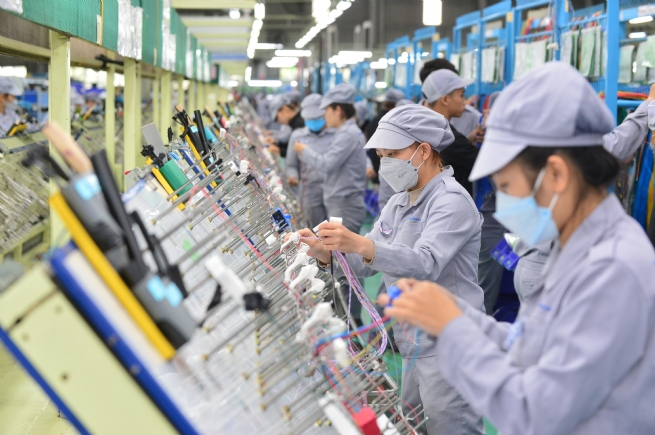10:04:12 AM | 5/12/2025
By increasing its value-added role in global supply chains, Vietnam can better capitalize on economic linkages, particularly amid current global trade tensions and economic disruptions.

At present, the number of Vietnamese enterprises participating in global supply chains remains modest
Participation in global value chains (GVCs) is influenced by resources, market size, geographic location, institutional quality and government policies. Vietnam's strategic position in Southeast Asia, with a long coastline and access to large markets, enhances its competitiveness in manufacturing and export-driven industries.
According to the Asian Development Bank (ADB), trade policies that promote an open economy and regional integration have reinforced Vietnam's role in the global production network. To foster a more favorable business environment, Vietnam has undertaken comprehensive reforms, including changes in land policies, fiscal restructuring, and industrial development strategies.
As the global economy evolves, Vietnam's advantages in integrating into GVCs are also shifting. The benefits from labor resources may diminish as the economy develops, and preferential market access under free trade agreements could decrease over time.
ADB's analysis highlights emerging factors influencing Vietnam's participation in GVCs, including geo-economic shifts, sustainable development trends such as decarbonization and energy transition, and digital transformation. These factors present both risks and opportunities, depending on how well Vietnamese actors in the GVCs adapt. Specifically, geo-economic shifts demand ongoing investment and business reforms, while sustainable development trends require effective public-private partnerships. Digital transformation calls for strong digital skills and technology adoption, including e-commerce, artificial intelligence and smart manufacturing. Adapting to these trends will enhance Vietnam’s position in the GVCs.
A major challenge for Vietnam in enhancing its participation in GVCs is the limited domestic linkages with leading foreign companies and a lack of collaboration among local suppliers. Additionally, insufficient innovation and a weak capacity for technology absorption hinder the upgrading of companies within the GVCs. Furthermore, the absence of a robust ecosystem to integrate small and medium enterprises (SMEs) into the GVCs creates coordination issues in policy implementation, particularly in trade, industrial development and SME support, ultimately reducing Vietnam's competitiveness.
Vietnam is facing significant labor productivity challenges and skill shortages, particularly in high-tech and digital sectors. Moving to higher value-added segments requires a more skilled workforce. As ADB recommended, "Despite its high-quality labor potential, Vietnam still needs broad-based upskilling to meet future workforce needs. Immediate action is required to close the skills gap and prepare the workforce to succeed in the global economy."
Challenges in trade connectivity, along with differences in policies and regulations, remain significant barriers for businesses. High trade costs, including tariffs and non-tariff measures, reduce the competitiveness of businesses in the GVC. Factors such as governance quality, policy discrepancies, transaction costs and transportation costs further increase trade costs, affecting the reliability of the GVC. Despite progress, Vietnam’s logistics performance index still lags behind regional peers, underscoring the need for improvements in infrastructure and customs efficiency.
Access to finance remains a significant challenge for Vietnamese businesses, limiting their growth, innovation and global competitiveness. According to the ADB, despite the government's efforts to improve credit access, many businesses still struggle to secure capital from traditional banks due to strict lending requirements, high interest rates and a lack of collateral. Additionally, limited financial literacy and inadequate credit information systems complicate access to finance, highlighting the need for reforms to enhance financial inclusion and support private sector growth.
In the long term, as labor costs rise, Vietnam must shift to higher value-added activities, enhance its technology absorption capacity and boost productivity. To meet these challenges, ADB emphasized the need to improve the competitiveness of domestic enterprises by promoting technology investment, research and development, and adopting international best practices for sustainable development. Deploying advanced technologies, such as supply chain management and quality management tools, will improve operational efficiency and responsiveness to market demands. To support this transformation, the Government can implement policies that expand infrastructure for efficient logistics, trade facilitation and digitalization to sustain competitiveness. Additionally, Vietnam needs more effective strategies, policies and programs to improve the integration of SMEs into global value chains. In particular, this means strengthening their connections with foreign-invested enterprises and supporting their participation in supply chains through these companies.n,
By Quynh Anh, Vietnam Business Forum